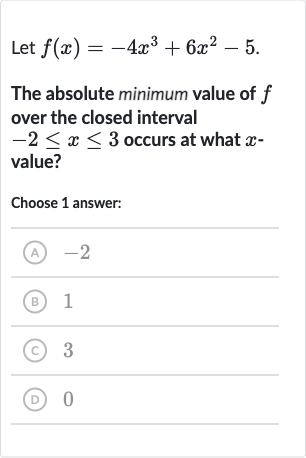Full solution
Q. Let .The absolute minimum value of over the closed interval occurs at what value?Choose answer:(A) (B) (C) (D)
- Find Derivative: To find the absolute minimum value of the function on the closed interval, we need to find the critical points of the function within the interval and evaluate the function at the endpoints of the interval.First, we find the derivative of the function ..
- Find Critical Points: Next, we find the critical points by setting the derivative equal to zero and solving for .
or
or - Evaluate Function: We have two critical points within the interval: and . Now we need to evaluate the function at these critical points and at the endpoints of the interval, and .
- Compare Values: Now we compare the values of at , , , and to find the smallest value, which will be the absolute minimum.The smallest value is .
- Find Absolute Minimum: The absolute minimum value of over the closed interval occurs at .
More problems from Solve quadratic inequalities
QuestionGet tutor help
QuestionGet tutor help
QuestionGet tutor help
QuestionGet tutor help
QuestionGet tutor help
QuestionGet tutor help
QuestionGet tutor help
QuestionGet tutor help

